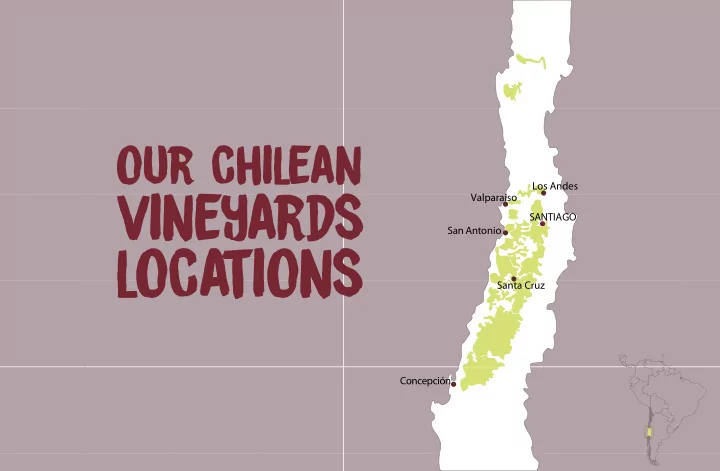

our chilean Los Andes vineyards Valparaiso SANTIAGO San Antonio loca tions Santa Cruz Concepción
Aconcagua Valley 846 Ha. Pacific Ocean The topography creates a distinctive climatic characteristic: Los Andes as the warm, dry land of the region heats up during the Valparaíso afternoon, the hot air in the east rises rapidly upwards, sucking in cooler air from the Pacific Ocean to the west. Santiago This process is reversed as the land cools down in the evening. These daily breezes moderate the otherwise high temperatures found in the Aconcagua Valley and reduce the risk of vine disease. The Antarctic 'Humboldt Current' which flows up the west coast of Chile helps to maintain this effect. Los Andes A great combination between boulders, gravels and clay in the piet mont of the valley. Secure a great quality a great production. Cabernet Sauvignon, Syrah and Merlot. Don Maximiano Errazuriz, Seña, La Cumbre Syrah, Tatay de Cristobal Carmenere.
Leyda Valley 1.200 Ha. Pacific Ocean The Pacific coast is 8 miles (12 km) west of Leyda Valley. This cool-climate region enjoys the effects of the cold Santiago San Antonio RM Humboldt Current of the Pacific Ocean. Cold ocean breezes and morning fog moderate the overall temperatures, and the valley is therefore significantly cooler than its low latitude might suggest. Los Andes Leyda Valley's soils are largely clay and loam over a granite base with moderate drainage. These low-fertility soils are good for the production of premium grapes because they make the vines struggle for survival. Sauvignon Blanc, Chardonnay, Pinot Noir and Syrah. Amayna Pinot Noir, Undurraga Pinot Noir, Amayna Sauvignon Blanc, Amaral Sauvignon Blanc, Viña Leyda Pinot Noir, San Pedro 1865 Sauvignon Blanc.
maipo Valley 9.895 Ha. Pacific Ocean Alto Maipo: warm sun during the day is followed by colder nights, which slow ripening. Central Maipo: slightly warmer than in Alto Maipo. Santiago Bajo Maipo: cool breezes create mesoclimates suitable for growing white-wine varieties Alto Maipo’s alluvial soils are rocky and free-draining. Vines have to work harder for water in the ground and so put Los Andes their energy into producing smaller berries with a high concentration of sugars and acids. In Central Maipo, the soils are slightly more clay-based and fertile Cabernet Sauvignon, Carmenere, Merlot, Syrah, Chardonnay and Sauvignon Blanc. Alma Viva, Don Melchor Cabernet Sauvignon, Casa Real Cabernet Sauvignon, Viñedo Chadwick.
peumo Valley 127 Ha. Pacific Ocean Long and dry summers, with very bright days. Sub-humid Mediterranean. Warm days and cool nights. Theinfluence of the Cachapoal River helps lower the nightime temperatures Santiago during the summer, wich encourages the grapes to ripen RM more slowly. Colchagua Deep alluvial silty-clay soil associated with riverbed. The clay retains water, wich contributes to good ripering of the Los Andes grapes. The caracteristics of the retention are perfect for controlling the grouth for the plants. Carmenere (The best growing area for Premium Carmener), Cabernet Sauvignon, Syrah. Carmín de Peumo, Santa Carolina Herencia Carmenere, Casa Lapostolle Carmenere.
colchagua Valley 19.539 Ha. Pacific Ocean Warm, but cooled by ocean breezes and dry, but refreshed by rivers and occasional rainfall. Santiago RM The degree of cooling provided by the ocean varies from east to west in the Colchagua Valley, demonstrated by the distribution of red and white grape varieties. Apalta Santa Cruz Free-draining granitic soils allow to control the vigor. The Los Andes Tinguiririca river brings clear meltwater down from the Andean peaks to the valleys and vineyards below, transporting silts and clays with it and creating ideal soils and terrains for viticulture. Cabernet Sauvignon, Carmenere, Syrah, Malbec, Merlot and Petit Verdot. Clos Apalta, Montes M, Montes Purple Angel Carmenere, Le Dix Los Vascos Cabernet Sauvignon, Ninquén Cabernet Sauvignon, Altura, Micro Terroir Carmenere, Viu 1 Gran Reserva Malbec.
Recommend
More recommend